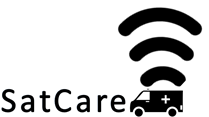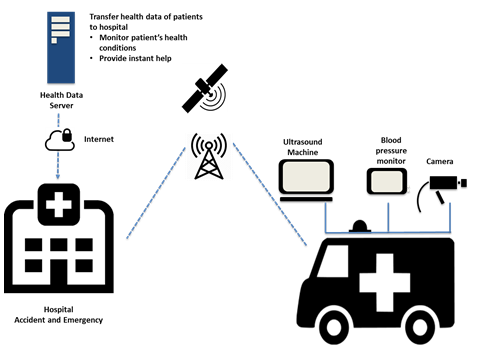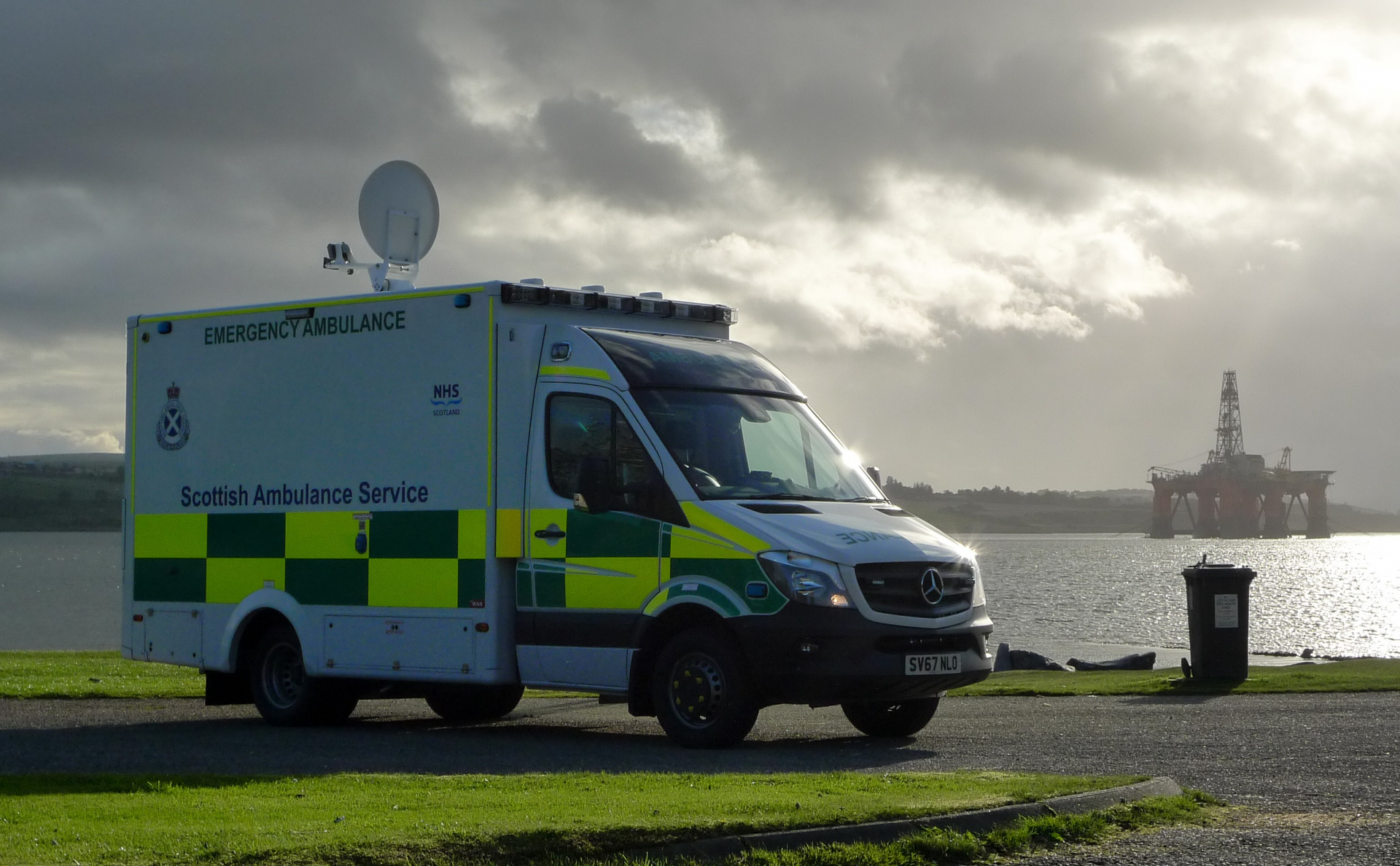
Objectives of the service
SatCare targets the improvement of first-aid services using remote diagnosis and treatment of patients on board ambulances. The objective of the project was to extend the capabilities of the first responders, allowing live interaction with remotely-based doctors and equipment, and the team in the field to deliver the correct treatment immediately, at the place of intervention or en route to the hospital.
The SatCare activity was based upon integrating satcom into remotely connected medical terminals and demonstrating the systems in operational trials over 12 months. The operational trials were designed to provide quantitative cost benefit analysis resulting from the two pilot cases, which was a key component to consider the commercialisation of the SatCare service.

Figure 1 Concept of connected ambulance
Key Issues
Developing a communication system that works across multiple channels.
The SatCare activity allows for video rich data to be used to transmit scans to the hospital from the vehicle on the scene of the emergency and en-route to the hospital. Through the addition of Satcom, it is possible to broaden the coverage of this service to include areas where LTE (Long Term Evolution i.e. terrestrial mobile broadband) is unavailable or over-subscribed. Thus a major challenge for the activity is the development of a communication management system that can efficiently and seamlessly bond multiple communication channels.
Integration of a satcom system on ambulances
The original aim of the SatCare activity was to provide a live feed of ultrasound from an ambulance on the move. The satcom terminal size and weight did not meet the Scottish Ambulance Service’s requirements, meaning the satcom terminal cannot be integrated currently on their ambulance fleet. The challenge for the SatCare project was to re-design an activity for telemedicine integrated with satcom in rural Scotland using a satcom terminal that was acceptable to the ambulance service This challenge has resulted in SatCare having two different satcom system architectures on trial, meeting the differing requirements of two ambulance services. This allows the SatCare system to demonstrate a wider range of requirements widening the potential customer base.
Coordination and performance of operational pilots in different countries.
The operational pilots of the SatCare system target Belgium and Scotland. The co-ordination of pilots in multiple countries can provide challenges including language barriers, differences in protocols, different health service requirements. For example, the initial users requirements assessment confirmed that the ambulance services of different countries have different requirements with regards to hardware integration on their ambulance. Considering this aspect, the SatCare activity has evolved to demonstrate two different pilot cases of ultrasound transmission.
Product Benefits
Benefits of real-time treatment:
- Reduce healthcare costs
- Saves lives
First aid diagnosis of patients and routing to the right care structure is time critical. In the example of stroke, there was 33 million worldwide cases in 2010, with stroke accounting for 11.13% of total deaths worldwide. Stroke is the leading preventable cause of disability. The earlier the patients are treated, the less likely they are to die or be left with long-term disabilities. Many stroke victims fail to arrive at the hospital within the necessary timeframe. If emergency medical personnel had a way to differentiate ischemic from hemorrhagic stroke in the ambulance, treatment could be started sooner, leading to more lives saved and less long-term disability.
Another use case could involve major internal bleeding, such as from a ruptured spleen. This will commonly kill a patient in 1-4 hours and little can be done in terms of treatment in the ambulance. Bleeding is easily identified with the FAST scan and information about the presence of blood in the abdominal cavity can be transmitted to the hospital emergency department, together with data about blood pressure, pulse rate and other vital signs. This information will be sufficient for the surgical team to be ready when the ambulance arrives, typically cutting 45 minutes off the time it normally takes to get someone into theatre for emergency surgery. This can have a major positive impact on the survival and recovery rates of the patient.
As recovery rates are improved, the financial costs of treating patients are also reduced.
Commercial Benefits:
The commercial benefits of the SatCare system include:
- Reduced cost of operations
- Increase business for first aid service provider
- Improved quality of treatment when it counts
- Improvement of workflow
The commercial benefits to the customer of the SatCare system can be seen in the improved outcomes for patients reducing the long-term care costs. For ambulance providers having an onboard ultrasound system gives them a unique selling point and can allow them access to other markets like civil or military applications. The addition of broadband satcom can also allow the transfer of large amount of data at a higher speed and lower cost than other satcom alternatives. For the satellite provider the communication system developed in SatCare can become a standard communication system for many remote connectivity applications and increase the market of broadband satcom.
Product Features
The emergency response vehicle is equipped with a mobile broadband Satcom link that improves the usage of current medical systems offering higher speed, better coverage, and a continuous communication link.
The use of broadband enables the deployment of diagnostic tools requiring the transfer of heavy data like ultrasound scans, video-conferencing between hospital and emergency response vehicle.
The more robust communication link and increased quality of data allows for supported clinical decision-making. The SatCare activity contributed to gather data about the potential cost savings to patient care that could be generated through the use of pre-hospital scanning with satellite transmission of the imaging data.
System Architecture
The main blocks of the SatCare connected ambulance architecture are:
- Diagnostic tools that include an ultrasound machine, video-conferencing unit, vital data sensors and a PC unit.
- The communication management system, which routes the communication channels and collect and store data.
- The communication equipment, which is made up of a mobile satcom terminal, LTE modules, WiFi system, and a positioning receiver.
- The Network Access is made through subscription and capacity of KaSat satellite network, broadband mobile networks and WiFi networks.
- The Hospital have the data storage centre, which is comprised of a bonding server collecting data through the Internet and operator stations for doctor interaction with the patient and for data analysis.
Current Status
The Final Review of the activity was held on 04 December 2020 and has led to the following conclusions:
Satcare CRH:
The SatCare trial successfully demonstrated that ultrasound scans and video summaries can be transmitted by Satcom from ambulances attending emergencies at remote locations to experts in a hospital ED. However, the limited patient numbers recruited meant that the planned extensive analyses, including health economic modelling, could not be performed. The process analysis was nevertheless helpful in discovering the barriers the trial encountered and identified relevant improvements and recommendations for any future trials.

SatCare antenna fitted to Scottish Ambulance
Satcare Zebra:
Satcoms land mobile capability to support telemedicine services were developed through significant mechanical, electronics and software upgrades of existing system. The final Satcare solution, allows almost continuous data flow with little impact to the connected perception of the patient-doctor connection. Despite live trials being hampered by the global Covid pandemic, road testing results proved that Telemedicine through a combination of Satcoms and Cellular can be used to enhance early patient care. Interest remains with hospitals and private ambulance companies to explore commercial trials once the global pandemic has passed.

SatCare antenna fitted to Belgian Ambulance



